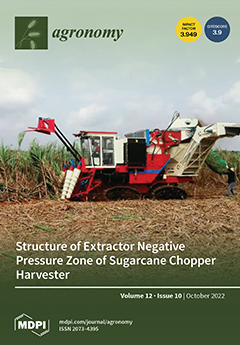The use of chemical pesticides to protect agricultural products is a global concern because of their adverse effects on the environment and public health. To avoid the dangers of synthetic herbicides, research has turned to natural alternatives. This study was conducted to evaluate the allelopathic effect of essential oil (EO) extracted from
Origanum syriacum,
Origanum onites, and
Origanum majorana. In addition, the chemical composition of the essential oil was elucidated by gas chromatography and mass spectrometry (GC–MS) analysis. A total of 11 different components of
O.syriacum were identified, and the main components were carvacrol (88.49),
p-Cymene (5.71), γ-Terpinene (1.63), β-Caryoplhyllene (1.48), and Terpinen-4-ol (0.65), respectively. For
O. onites, 10 different compounds were identified, and the main components were carvacrol (58.65), Thymol (30.97), Linalool (4.17),
p-Cymene (1.94), and β-Caryoplhyllene (0.98), respectively. Finally, for
O. majorana, 14 different compounds were identified, and the main components were carvacrol (40.57), α-Terpineol (29.28),
p-Cymene (9.02), γ-Terpinene (5.80), and carvacrol methyl ether (3.46). Finally, 14 compounds from the
Origanum majorana species were identified, with carvacrol (40.57), -Terpineol (29.28),
p-Cymene (9.02), and -Terpinene (5.80) as the parent compound (3.46). Oxygenated monoterpenes were the highest in all species’ EO content. EOs and plant extracts were tested at 5, 10, and 20 L/Petri concentrations against seed germination and seedling growth in four weed species (
Thlaspi arvense,
Amaranthus retroflexus,
Rumex cripus, and
Lactuca serriola). The concentrations of essential oil were set as 5, 10, and 20 µL/Petri dishes for seed germination. In the greenhouse experiment, the final concentration of solutions was set as 20 µL and the solutions were directly sprayed on the surface of the weeds, and the mortality rates were noted after 24 and 48 h of application. It was observed that increasing the application decreased seed germination. The phytotoxic effects on the seedling germination in the greenhouse were observed, resulting in 48.76–94% mortality rates. Consequently, the essential oil from
Origanum species could be considered as an alternative bio-herbicide to tested weeds.
Full article





